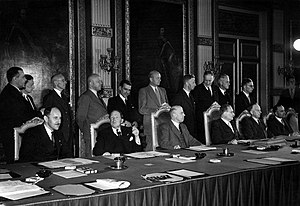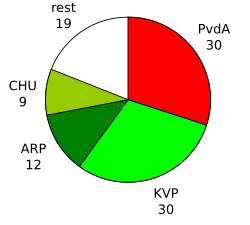Second Drees cabinet Third Drees cabinet | |
|---|---|
Cabinet of the Netherlands | |
  First meeting of the cabinet in the Trêveszaal on 2 September 1952 | |
| Date formed | 2 September 1952 |
| Date dissolved | 13 October 1956 4 years, 41 days in office (Demissionary from 13 June 1956) |
| People and organisations | |
| Monarch | Queen Juliana |
| Prime Minister | Willem Drees |
| Deputy Prime Minister | Louis Beel |
| No. of ministers | 17 |
| Ministers removed | 3 |
| Total no. of members | 16 |
| Member party | Labour Party (PvdA) Catholic People's Party (KVP) Anti-Revolutionary Party (ARP) Christian Historical Union (CHU) |
| Status in legislature | Centre-left[1] Majority government (Grand coalition/Roman-Red) |
| History | |
| Election | 1952 election |
| Outgoing election | 1956 election |
| Legislature terms | 1952–1956 |
| Incoming formation | 1952 formation |
| Outgoing formation | 1956 formation |
| Predecessor | First Drees cabinet |
| Successor | Third Drees cabinet |
| Part of the Politics series |
![Azure, billetty Or a lion with a coronet Or armed and langued Gules holding in his dexter paw a sword Argent hilted Or and in the sinister paw seven arrows Argent pointed and bound together Or. [The seven arrows stand for the seven provinces of the Union of Utrecht.] The shield is crowned with the (Dutch) royal crown and supported by two lions Or armed and langued gules. They stand on a scroll Azure with the text (Or) "Je Maintiendrai" (French for "I will maintain".)](http://upload.wikimedia.org/wikipedia/commons/thumb/8/8f/State_coat_of_arms_of_the_Netherlands.svg/150px-State_coat_of_arms_of_the_Netherlands.svg.png) |
|---|
|
|
The Second Drees cabinet, also called the Third Drees cabinet[2] was the executive branch of the Dutch Government from 2 September 1952 until 13 October 1956. The cabinet was formed by the social-democratic Labour Party (PvdA) and the Christian-democratic Catholic People's Party (KVP), Anti-Revolutionary Party (ARP) and Christian Historical Union (CHU) after the election of 1952. The cabinet was a Centre-left[3] grand coalition and had a majority in the House of Representatives with Labour Leader Willem Drees serving as Prime Minister. Former Catholic Prime Minister Louis Beel served as Deputy Prime Minister and Minister of the Interior.
The cabinet served during early years of the turbulent 1950s. Domestically the recovery and rebuilding following World War II continued with the assistance of the Marshall Plan, it also able to finalize several major social reforms to social security, welfare, child benefits and education from the previous cabinet. Internationally the decolonization of the Dutch East Indies following the Indonesian National Revolution continued. The cabinet suffered no major internal and external conflicts and completed its entire term and was succeeded by the Third Drees cabinet following the election of 1956.[4]
- ^ Changing Liaisons The Dynamics of Social Partnership in 20th Century West-European DemocraciesBy Karel Davids, 2007, P.165
- ^ According to a different numbering this was the Fourth Drees cabinet because it was the third cabinet with Willem Drees as Prime Minister.
- ^ Changing Liaisons The Dynamics of Social Partnership in 20th Century West-European DemocraciesBy Karel Davids, 2007, P.165
- ^ "Coalities tussen sociaaldemocraten en confessionelen" (in Dutch). Historisch Nieuwsblad. 10 August 2006. Retrieved 24 April 2018.